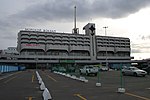Great Port of Saint Petersburg
Ports and harbours of RussiaTransport in Saint PetersburgWater transport in Russia
The Great Port of St. Petersburg or Port of St. Petersburg is a major seaport serving the city of St. Petersburg in northwest Russia. The port's water area is 164.6 km2 (630,000 square meters). The mooring line is 31 km long and the water is 25 metres (82 ft) deep at the port's deepest anchorages. Since 2011, the port has been under the authority of a state-owned enterprise (federal government agency), the Port Authority of the Great Port of St. Petersburg. This agency oversees commercial navigation in the seaport of St. Petersburg and beyond in the designated areas of responsibility of the Russian Federation.
Excerpt from the Wikipedia article Great Port of Saint Petersburg (License: CC BY-SA 3.0, Authors).Great Port of Saint Petersburg
дорога в Угольную гавань, Saint Petersburg Ugolnaya Gavan (округ Автово)
Geographical coordinates (GPS) Address Phone number Website Nearby Places Show on map
Geographical coordinates (GPS)
| Latitude | Longitude |
|---|---|
| N 59.880555555556 ° | E 30.199166666667 ° |
Address
Первый Контейнерный Терминал причал 86
дорога в Угольную гавань 17
198096 Saint Petersburg, Ugolnaya Gavan (округ Автово)
Saint Petersburg, Russia
Open on Google Maps










